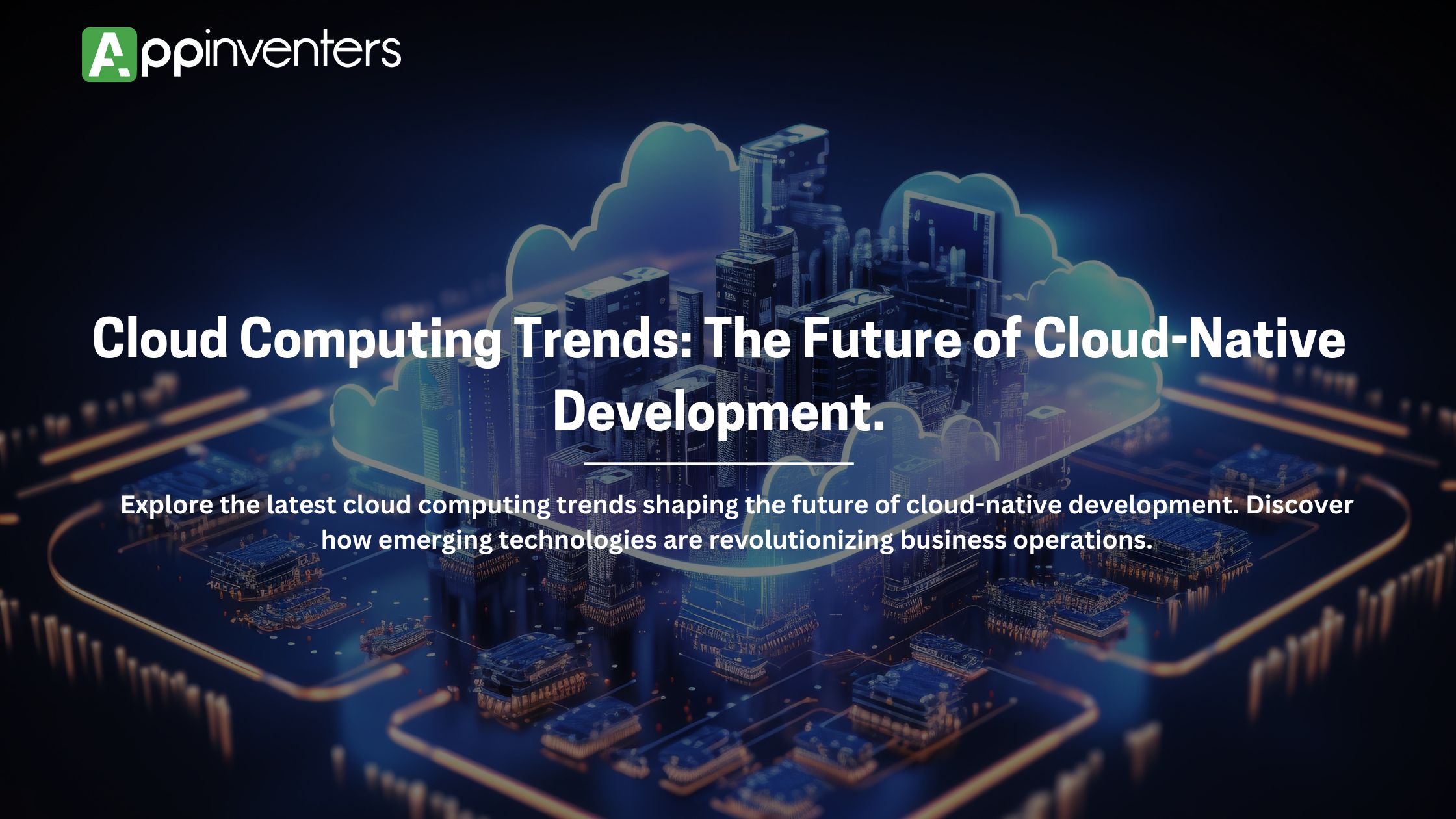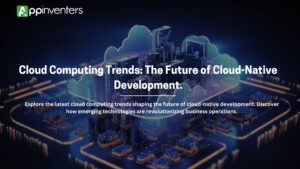In the realm of technology, cloud computing has emerged as a transformative force, reshaping the operational landscape of businesses. A recent industry report forecasts the global cloud computing market to ascend to a monumental $1.25 trillion by 2028, with a compound annual growth rate of 19.1% over the ensuing six years. This exponential expansion underscores the profound influence of cloud-native development on the future of IT infrastructure and business strategies.
As entities endeavor to maintain their competitive edge, they are increasingly adopting cloud-native development. This paradigm leverages the inherent benefits of cloud computing to foster innovation, agility, and scalability. This section explores the pivotal trends shaping the future of cloud-native development, encompassing the ascendance of microservices and containerization, alongside the advent of edge computing and serverless architectures.
Key Takeaways
- The global cloud computing market is projected to reach $1.25 trillion by 2028, underscoring the transformative power of cloud-native development.
- Cloud-native development enables organizations to harness the agility, scalability, and cost-efficiency of the cloud to drive innovation and remain competitive.
- Microservices architecture and containerization are revolutionizing application development and deployment, offering increased flexibility and resilience.
- Edge computing and serverless computing are redefining the landscape of cloud infrastructure, enabling data processing closer to the source and reducing operational complexity.
- Hybrid and multi-cloud strategies are gaining traction, providing organizations with the flexibility to optimize their cloud infrastructure for specific workloads and requirements.
Embracing Cloud-Native Development
In the rapidly evolving tech landscape, businesses are increasingly adopting cloud-native development to leverage the capabilities of modern cloud computing. This methodology, centered on microservices architecture and containerization, brings forth numerous advantages that are revolutionizing application development and deployment.
Microservices Architecture
At the core of cloud-native development is the microservices architecture. By fragmenting applications into smaller, autonomous services, this paradigm fosters greater flexibility, scalability, and agility. Developers can now concentrate on crafting and deploying individual components, rather than managing a unified codebase. This leads to expedited time-to-market and heightened responsiveness to shifting business requirements.
Containerization and Container Orchestration
Containerization, a pivotal aspect of cloud-native development, enables the encapsulation of applications and their dependencies within self-contained units. These containers can be effortlessly deployed, scaled, and managed across diverse computing environments, ensuring uniform and dependable application behavior. Moreover, container orchestration tools, such as Kubernetes, have emerged as formidable platforms for overseeing and scaling containerized applications, thereby streamlining cloud-native development.
| Benefits of Cloud-Native Development | Microservices Architecture | Containerization and Container Orchestration |
|---|---|---|
| Improved scalability and flexibility | Modular and independent services | Consistent and reliable application behavior |
| Faster time-to-market | Improved development and deployment efficiency | Ease of deployment and scaling |
| Enhanced responsiveness to changing business needs | Ability to scale individual components | Efficient resource utilization |
| Increased reliability and resilience | Enhanced fault tolerance and recoverability | Improved cross-platform compatibility |
As organizations delve deeper into cloud-native development, they are experiencing the fruits of enhanced efficiency, scalability, and agility. By harnessing the strengths of microservices architecture and containerization, they are able to navigate the ever-changing landscape with ease. This enables them to deliver cutting-edge solutions that meet the evolving demands of their clientele.
Cloud Computing Trends: Edge Computing and Serverless
The evolution of cloud computing is marked by the emergence of edge computing and serverless computing, two transformative trends. These innovations are revolutionizing data processing and infrastructure management, facilitating accelerated response times, enhanced efficiency, and cost reduction. They are pivotal in redefining our approach to data handling and infrastructure management.
Edge Computing: Bringing Processing Closer to the Source
Edge computing represents a decentralized paradigm, positioning data processing and analysis proximal to data origination, diverging from centralized cloud infrastructures. This model diminishes latency, elevates responsiveness, and curtails the necessity for incessant data transmission to the cloud. It is especially advantageous for applications necessitating immediate decision-making, such as autonomous vehicles, industrial automation, and IoT (Internet of Things) devices.
Serverless Computing: Scaling on Demand
Serverless computing, a cloud-based architecture, empowers developers to create and deploy applications without the burden of managing underlying infrastructure. The cloud provider assumes responsibility for provisioning, scaling, and managing computing resources, allowing developers to concentrate exclusively on coding and deployment. This paradigm offers significant benefits, including pay-per-use pricing, automatic scaling, and diminished operational overhead.
| Feature | Edge Computing | Serverless Computing |
|---|---|---|
| Data Processing | Decentralized, closer to the source | Centralized in the cloud |
| Scalability | Limited by edge device capabilities | Automatic, on-demand scaling |
| Cost Model | Upfront investment in edge devices | Pay-per-use, no upfront costs |
| Latency | Reduced latency, real-time processing | Higher latency, depending on cloud proximity |
As the cloud continues to gain traction, edge computing and serverless computing are set to be instrumental in molding the future of cloud-native development. By harnessing these technologies, enterprises can attain unprecedented levels of efficiency, agility, and cost-effectiveness, positioning them at the forefront of the rapidly evolving digital realm.
Hybrid and Multi-Cloud Strategies
The evolution of cloud computing has led to a surge in the adoption of hybrid and multi-cloud strategies. These methodologies combine on-premises and public cloud infrastructure, offering enhanced cloud flexibility and cloud resilience. Such approaches are pivotal for businesses aiming to optimize their IT infrastructure and adapt to changing market demands.
Hybrid Cloud Solutions
Hybrid cloud solutions integrate on-premises data centers with public cloud services, creating a dynamic IT infrastructure. This integration allows organizations to retain control over critical data and applications while benefiting from the scalability and cost-effectiveness of public clouds. By merging the strengths of both environments, hybrid cloud solutions empower businesses to optimize workload and data placement according to their specific needs.
Multi-Cloud Strategies for Flexibility and Resilience
Adopting multi-cloud strategies that span across multiple cloud service providers is another trend gaining traction. This strategy enhances cloud flexibility and cloud resilience. By diversifying their cloud infrastructure, organizations can mitigate vendor lock-in, reduce the risk of service outages, and leverage the unique strengths of each cloud platform to meet their evolving requirements.
| Hybrid Cloud Solutions | Multi-Cloud Strategies |
|---|---|
| Combines on-premises and public cloud infrastructure | Utilizes multiple cloud service providers |
| Maintains control over sensitive data and applications | Avoids vendor lock-in and enhances resilience |
| Leverages the scalability and cost-effectiveness of the public cloud | Enables businesses to leverage unique cloud platform capabilities |
The increasing adoption of hybrid cloud solutions and multi-cloud approaches reflects a broader trend in cloud strategy optimization. These innovative strategies are crucial for achieving greater cloud flexibility and cloud resilience, enabling businesses to thrive in the ever-changing cloud computing landscape.
AI-Driven Cloud Services and Automation
In the rapidly evolving world of cloud computing, the integration of artificial intelligence (AI) and automation is transforming the way organizations optimize their cloud-based operations. AI-driven cloud services are empowering businesses to streamline decision-making, enhance efficiency, and strengthen cloud governance like never before.
One of the key benefits of AI-driven cloud services is the ability to automate repetitive tasks and processes. Through machine learning algorithms, cloud platforms can autonomously provision resources, configure settings, and monitor performance, freeing up valuable time and resources for more strategic initiatives. This cloud automation not only improves operational efficiency but also enhances the overall reliability and scalability of cloud-native environments.
Moreover, AI-powered analytics and insights are revolutionizing cloud governance, enabling organizations to make more informed decisions regarding resource allocation, cost optimization, and security management. By leveraging predictive analytics and anomaly detection, cloud administrators can proactively identify and address potential issues before they escalate, ensuring the seamless and secure operation of their cloud infrastructure.
| Key Benefits of AI-Driven Cloud Services | Metrics |
|---|---|
| Improved Operational Efficiency | 25% reduction in manual cloud management tasks |
| Enhanced Cloud Governance | 30% decrease in cloud infrastructure-related security incidents |
| Increased Cost Optimization | 20% reduction in cloud spending through intelligent resource allocation |
As the adoption of cloud computing continues to accelerate, the integration of AI and automation is poised to become a crucial differentiator for organizations seeking to maximize the potential of their cloud-native investments. By embracing these cutting-edge technologies, businesses can unlock new levels of efficiency, agility, and cloud governance, positioning themselves for long-term success in the rapidly evolving cloud landscape.
“AI-driven cloud services are revolutionizing the way businesses manage their cloud infrastructure, empowering them to make smarter decisions, optimize resources, and enhance overall operational efficiency.”
Cloud Security and Sustainability
In the dynamic realm of cloud computing, two pivotal elements have emerged: cloud security and sustainable cloud practices. As entities increasingly rely on the cloud for their data and infrastructure, the necessity for stringent security protocols has escalated. Concurrently, the escalating environmental consciousness has catalyzed a significant increase in the demand for green cloud computing solutions. These solutions aim to diminish the ecological footprint of cloud-based operations.
Securing the Cloud
Cloud security has ascended to a paramount concern for both enterprises and individuals. The imperative to protect sensitive data, thwart cyber threats, and preserve the integrity of cloud infrastructure is fundamental to a comprehensive cloud security strategy. Employing advanced encryption methodologies, multi-factor authentication, and stringent access controls are among the strategies employed to bolster cloud environments. These measures are designed to counteract the risks of data breaches and unauthorized access.
Greening the Cloud
The industry has concurrently witnessed a heightened focus on green cloud computing. This paradigm shift endeavors to diminish the environmental repercussions of cloud-based operations through the optimization of energy consumption, promotion of renewable energy sources, and implementation of sustainable data center practices. Cloud service providers are increasingly committing to renewable energy initiatives and adopting energy-efficient technologies. These efforts are aimed at reducing their carbon footprint and fostering a more sustainable future.
| Cloud Security Measures | Green Cloud Computing Initiatives |
|---|---|
| Encryption | Renewable energy powering data centers |
| Multi-factor authentication | Energy-efficient hardware and infrastructure |
| Access controls | Virtualization and containerization |
| Intrusion detection and prevention | Sustainable data center design and operations |
| Compliance and regulatory adherence | Waste management and recycling initiatives |
As the cloud computing sector continues to evolve, the dual emphasis on cloud security and green cloud computing will remain indispensable. These elements are crucial for safeguarding sensitive data and preserving our environment. By harmonizing these two critical aspects, entities can fully harness the potential of cloud-based technologies while contributing to a more sustainable future.
“The future of cloud computing lies in the seamless integration of robust security measures and environmentally responsible practices.”
Conclusion
In the swiftly evolving realm of cloud computing, the trends and advancements discussed in this article provide insight into the trajectory of cloud-native development. The ascendancy of microservices architecture and containerization, coupled with the increasing significance of edge computing and serverless solutions, underscores the transformative impact on business operations and innovation. This evolution reshapes the cloud ecosystem, propelling it towards unprecedented levels of efficiency and adaptability.
Entities that actively adopt these cloud-native paradigms and technologies will be at the forefront of digital transformation. They will experience enhanced operational efficiency and maintain a competitive advantage in the forthcoming years. By integrating hybrid and multi-cloud deployments, AI-driven cloud services, and robust security protocols, organizations can unlock novel avenues for growth and adaptability.
The trajectory of cloud computing’s evolution is clear, with cloud-native development’s future brimming with potential. By remaining abreast of the latest trends and advancements, businesses can adeptly navigate the complexities of the cloud landscape. This enables them to fully exploit the capabilities of cloud-based solutions, thereby achieving their strategic objectives and thriving in the digital era.
FAQ
What are the key cloud computing trends shaping the future of cloud-native development?
The evolution of cloud computing is marked by several pivotal trends. These include the advent of edge computing, which brings processing closer to data sources, and serverless computing, which abstracts infrastructure management. Hybrid cloud solutions and multi-cloud strategies are also gaining prominence, offering flexibility and resilience. Furthermore, AI-driven cloud services, cloud automation, enhanced security measures, and green cloud computing initiatives are redefining the landscape of cloud-native development.
How is microservices architecture transforming cloud-native development?
Microservices architecture is revolutionizing cloud-native development by fostering scalability, flexibility, and efficiency. By fragmenting monolithic applications into smaller, interconnected services, it enables independent development, deployment, and scaling. This approach accelerates time-to-market and enhances user experiences, making it a cornerstone of modern application development.
What are the benefits of containerization and container orchestration in cloud-native environments?
Containerization and container orchestration tools, such as Docker and Kubernetes, are fundamental to cloud-native development. They facilitate the consistent, portable, and scalable deployment of applications, thereby enhancing the reliability and resilience of cloud-based systems. These technologies streamline the packaging, deployment, and management of applications, making them indispensable in cloud-native environments.
How are edge computing and serverless computing transforming cloud infrastructure?
Edge computing and serverless computing are transforming cloud infrastructure by redefining data processing and management. Edge computing reduces latency and bandwidth requirements by processing data closer to its source. Serverless computing, on the other hand, abstracts infrastructure management, allowing developers to focus on application development without server management burdens.
What are the advantages of hybrid and multi-cloud strategies for cloud-native development?
Hybrid cloud solutions combine on-premises and public cloud infrastructure, offering flexibility, security, and cost optimization. Multi-cloud strategies leverage multiple cloud service providers, enhancing resilience, flexibility, and vendor diversity. These approaches provide organizations with greater control and options for their cloud-native applications, ensuring adaptability and scalability.
How are AI-driven cloud services and automation transforming cloud governance and operations?
AI-driven cloud services and automation are revolutionizing cloud governance and operations. Intelligent cloud solutions powered by artificial intelligence automate tasks such as resource provisioning, scaling, and optimization, leading to enhanced efficiency and cost savings. These technologies also enable robust cloud governance frameworks, ensuring compliance, security, and optimal resource utilization.
What are the key considerations for cloud security and sustainability in cloud-native environments?
Cloud security and sustainability are paramount in cloud-native environments. Ensuring data and infrastructure protection from cyber threats, maintaining regulatory compliance, and implementing robust identity and access management controls are critical. Additionally, the growing emphasis on green cloud computing is driving the adoption of sustainable cloud practices and technologies, aiming to reduce environmental impact.












